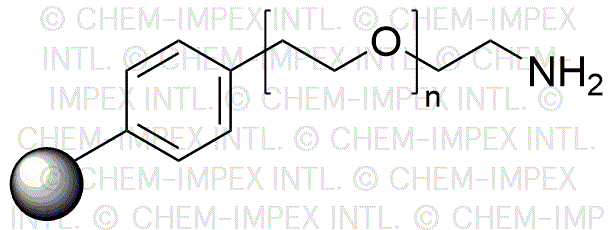TentaGel S NH2 (0.2 - 0.35 mmol/g, 130 µm) is widely utilized in research focused on:
- Peptide Synthesis: This chemical is an ideal support for solid-phase peptide synthesis, allowing researchers to efficiently create peptides with high purity and yield.
- Drug Development: It serves as a versatile platform for developing new pharmaceuticals by facilitating the synthesis of compound libraries for screening.
- Bioconjugation: TentaGel S NH2 can be used to attach biomolecules, such as proteins or nucleotides, to surfaces, enhancing the functionality of biosensors and diagnostic tools.
- Material Science: In polymer chemistry, it is employed to create functionalized materials that can be tailored for specific applications, such as drug delivery systems.
- High-Throughput Screening: Its properties make it suitable for high-throughput screening processes, allowing researchers to quickly evaluate a large number of compounds for biological activity.
General Information
Properties
Safety and Regulations
Applications
TentaGel S NH2 (0.2 - 0.35 mmol/g, 130 µm) is widely utilized in research focused on:
- Peptide Synthesis: This chemical is an ideal support for solid-phase peptide synthesis, allowing researchers to efficiently create peptides with high purity and yield.
- Drug Development: It serves as a versatile platform for developing new pharmaceuticals by facilitating the synthesis of compound libraries for screening.
- Bioconjugation: TentaGel S NH2 can be used to attach biomolecules, such as proteins or nucleotides, to surfaces, enhancing the functionality of biosensors and diagnostic tools.
- Material Science: In polymer chemistry, it is employed to create functionalized materials that can be tailored for specific applications, such as drug delivery systems.
- High-Throughput Screening: Its properties make it suitable for high-throughput screening processes, allowing researchers to quickly evaluate a large number of compounds for biological activity.
Documents
Safety Data Sheets (SDS)
The SDS provides comprehensive safety information on handling, storage, and disposal of the product.
Product Specification (PS)
The PS provides a comprehensive breakdown of the product’s properties, including chemical composition, physical state, purity, and storage requirements. It also details acceptable quality ranges and the product's intended applications.
Certificates of Analysis (COA)
Search for Certificates of Analysis (COA) by entering the products Lot Number. Lot and Batch Numbers can be found on a product’s label following the words ‘Lot’ or ‘Batch’.
Número de catálogo
Número de lote/lote
Certificates Of Origin (COO)
This COO confirms the country where the product was manufactured, and also details the materials and components used in it and whether it is derived from natural, synthetic, or other specific sources. This certificate may be required for customs, trade, and regulatory compliance.
Número de catálogo
Número de lote/lote
Safety Data Sheets (SDS)
The SDS provides comprehensive safety information on handling, storage, and disposal of the product.
DownloadProduct Specification (PS)
The PS provides a comprehensive breakdown of the product’s properties, including chemical composition, physical state, purity, and storage requirements. It also details acceptable quality ranges and the product's intended applications.
DownloadCertificates of Analysis (COA)
Search for Certificates of Analysis (COA) by entering the products Lot Number. Lot and Batch Numbers can be found on a product’s label following the words ‘Lot’ or ‘Batch’.
Número de catálogo
Número de lote/lote
Certificates Of Origin (COO)
This COO confirms the country where the product was manufactured, and also details the materials and components used in it and whether it is derived from natural, synthetic, or other specific sources. This certificate may be required for customs, trade, and regulatory compliance.

